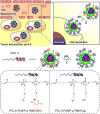Biodegradable Stimuli-Responsive Polymeric Micelles for Treatment of Malignancy
- PMID: 26873075
- PMCID: PMC5973479
- DOI: 10.2174/138920101703160206142821
Biodegradable Stimuli-Responsive Polymeric Micelles for Treatment of Malignancy
Abstract
In the past decade, drug delivery systems that can respond to the tumor microenvironment or external stimuli have emerged as promising platforms for treating malignancies due to their improved antitumor efficacy and reduced side effects. In particular, biodegradable polymeric micelles have attracted increasing attention and been rapidly developed as a distinct therapeutic to overcome limitations of conventional chemotherapeutic anticancer drugs. Because of their advantages with respect to biocompatibility, degradability, circulation time, and tumor accumulation, considerable effort has been dedicated to the developing and optimizing micellar systems during the past few years. This review highlights recent advances concerning stimuli-responsive micelles made of biodegradable polypeptide and polyester as nanocarries for drug delivery, and especially limits the content to pH sensitive, redox sensitive, and photo-sensitive micellar systems for safe and efficient cancer chemotherapy.
Conflict of interest statement
The author(s) confirm that this article content has no conflict of interest.
Figures




Similar articles
-
Classification of stimuli-responsive polymers as anticancer drug delivery systems.Drug Deliv. 2015 Feb;22(2):145-55. doi: 10.3109/10717544.2014.887157. Epub 2014 Feb 19. Drug Deliv. 2015. PMID: 24547737 Review.
-
Stimuli-responsive polymeric micelles for drug delivery and cancer therapy.Int J Nanomedicine. 2018 May 18;13:2921-2942. doi: 10.2147/IJN.S158696. eCollection 2018. Int J Nanomedicine. 2018. PMID: 29849457 Free PMC article. Review.
-
pH/redox dual-responsive amphiphilic zwitterionic polymers with a precisely controlled structure as anti-cancer drug carriers.Biomater Sci. 2019 Aug 1;7(8):3190-3203. doi: 10.1039/c9bm00407f. Epub 2019 May 30. Biomater Sci. 2019. PMID: 31145392
-
Advances of Stimuli-Responsive Amphiphilic Copolymer Micelles in Tumor Therapy.Int J Nanomedicine. 2025 Jan 1;20:1-24. doi: 10.2147/IJN.S495387. eCollection 2025. Int J Nanomedicine. 2025. PMID: 39776491 Free PMC article. Review.
-
[Advances in the study of tumor pH-responsive polymeric micelles for cancer drug targeting delivery].Yao Xue Xue Bao. 2009 Dec;44(12):1328-35. Yao Xue Xue Bao. 2009. PMID: 21351464 Review. Chinese.
Cited by
-
Exploration of Site-Specific Drug Targeting-A Review on EPR-, Stimuli-, Chemical-, and Receptor-Based Approaches as Potential Drug Targeting Methods in Cancer Treatment.J Oncol. 2022 Sep 29;2022:9396760. doi: 10.1155/2022/9396760. eCollection 2022. J Oncol. 2022. PMID: 36284633 Free PMC article. Review.
-
Nanocarrier cancer therapeutics with functional stimuli-responsive mechanisms.J Nanobiotechnology. 2022 Mar 24;20(1):152. doi: 10.1186/s12951-022-01364-2. J Nanobiotechnology. 2022. PMID: 35331246 Free PMC article. Review.
-
DNA Based and Stimuli-Responsive Smart Nanocarrier for Diagnosis and Treatment of Cancer: Applications and Challenges.Cancers (Basel). 2021 Jul 6;13(14):3396. doi: 10.3390/cancers13143396. Cancers (Basel). 2021. PMID: 34298610 Free PMC article. Review.
-
Improved Photodynamic Therapy Efficacy of Protoporphyrin IX-Loaded Polymeric Micelles Using Erlotinib Pretreatment.Biomacromolecules. 2017 Jun 12;18(6):1836-1844. doi: 10.1021/acs.biomac.7b00274. Epub 2017 May 1. Biomacromolecules. 2017. PMID: 28437090 Free PMC article.
-
Theranostic Diagnostics.Results Probl Cell Differ. 2024;73:551-578. doi: 10.1007/978-3-031-62036-2_22. Results Probl Cell Differ. 2024. PMID: 39242393 Review.
References
-
- Jemal A, Bray F, Center MM, Ferlay J, Ward E, Forman D. Global cancer statistics. CA Cancer J Clin. 2011;61(2):69–90. - PubMed
-
- Gonzalez-Angulo AM, Morales-Vasquez F, Hortobagyi GN. Overview of resistance to systemic therapy in patients with breast cancer. Breast Cancer Chemosensitivity. 2007;608:1–22. - PubMed
-
- Brindle K. New approaches for imaging tumour responses to treatment. Nat Rev Cancer. 2008;8(2):94–107. - PubMed
-
- Cho KJ, Wang X, Nie S, Chen ZG, Shin DM. Therapeutic nanoparticles for drug delivery in cancer. Clin Cancer Res. 2008;14(5):1310–1316. - PubMed
-
- Szakacs G, Paterson JK, Ludwig JA, Booth-Genthe C, Gottesman MM. Targeting multidrug resistance in cancer. Nat Rev Drug Discov. 2006;5(3):219–234. - PubMed
Publication types
MeSH terms
Substances
Grants and funding
LinkOut - more resources
Full Text Sources
Other Literature Sources
Miscellaneous

